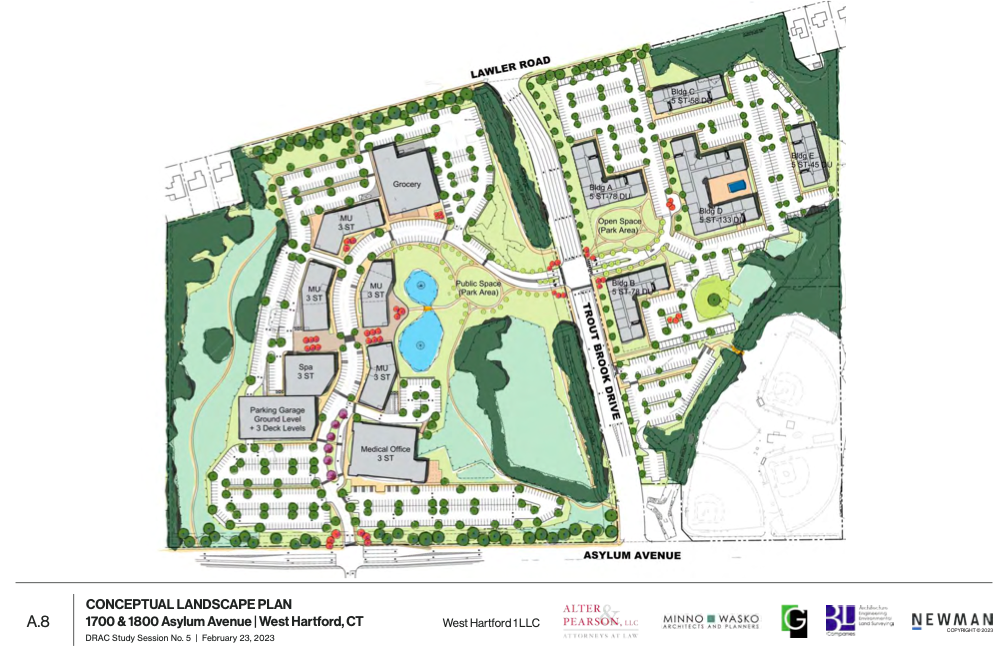Letter: Plans for UConn Campus Should be More Imaginative and Forward-Thinking

Audio By Carbonatix

Overall proposed schematic of buildings and landscaping plans. Screenshot of West Hartford 1 LLC submitted plans on Town of West Hartford website.
We-Ha.com welcomes Letters to the Editor from the public, including endorsements. Letters submitted by political candidates will be considered for publication up to 14 days prior to an election and most will be published within 48 hours of receipt. Letters that contain personal attacks or include profanity of any type will not be published. Rebuttals to letters should be submitted as a separate document, and commenting on letters will no longer be permitted. Please provide your full name and town, as well as your phone number at the end of the letter. Phone numbers will not be published but are required in case verification is needed. Please submit letters to [email protected].
Dear West Hartford Leaders,
My name is Josiah Blackwell-Lipkind. I grew up in West Hartford and was educated in the West Hartford Public Schools system: Webster Hill Elementary, Sedgwick Middle, and Conard High Schools. I studied Economics and Philosophy at Brown University and graduated in 2021. I now live in DC, working on freight transportation planning with CPCS Transcom and pursuing a Master’s degree at Georgetown University in Urban and Regional Planning. My parents continue to live in West Hartford, approaching their 23rd year as homeowners.
I carefully reviewed the Hartford Courant and We-Ha.com articles outlining the plans for the former UConn Campus property offered by West Hartford 1 LLC. I am glad that these are preliminary drafts because many aspects of the proposal are disappointingly conventional. West Hartford has a unique opportunity here to develop a high-potential 58-acre lot, the size of which the town may not see again for many years. I would love to see the town set itself apart with imaginative, forward-thinking development at the former UConn site.
My main objection pertains to the quantity of parking, especially surface parking. There is no rational reason to provide 1,900 surface parking spaces for 492 residential units. I understand that General Regulations dictate parking minimums (which I think should be eliminated, but this is a discussion for another day). By statute, multifamily housing must have 1.5 parking spaces per dwelling unit. Retail, restaurants, and medical offices add more need. But how we get to 1,900 surface lot spaces in addition to a three-floor garage baffles me.
Why encourage largely local vehicle travel, especially when residents already complain of traffic issues? From the development site, a bike ride to West Hartford Center or to Hall High School takes 10 minutes. There are bus stops on Asylum Avenue, providing access to Downtown Hartford in 20 minutes. Walking to Bishops Corner (ideally via a pedestrian connection at Diana Road) takes 5 to 10 minutes. Shouldn’t we be encouraging alternative modes of travel, with improved bike lanes, better bus service, and safer, more pleasant walking, instead of trying to accommodate auto-only travel?
With respect to any necessary parking, let’s not place it next to a wetland, in a moat around buildings, or as a barrier between the street and the development. Bring buildings up to the street and put parking behind. Encourage people to stroll along storefronts. Tempt travelers on Trout Brook Drive and Asylum Avenue with a neighborhood, not a sea of parking. The goal is to create a community, not a mall! The current proposal appears to be designed for speedy driving, which would be more appropriate in an exurban subdivision than in a densifying, inner-ring suburb.
I would also suggest that the plan incorporate narrower, more inter-connected streets with better connections to Lawler Road. Streets should be designed to move people between amenities, not to shuttle vehicles to and from connector road and surface parking lot. Curvy roads are unnecessary, again suited for an exurban community rather than in the midst of an existing street grid. Make bike lanes integral from the start. Trout Brook Drive should get a road diet, with bike lanes, a median, and reduced and narrowed travel lanes. This is especially true if the community green and walking trails are to abut Trout Brook Drive; no one wants their kids playing next to or crossing a glorified highway.
If I had it my way, the 58-acre site would incorporate more than 492 units of housing. Additional housing would not only make the neighborhood more appealing to those already inclined to live there (people with a taste for density) but would also offer the Town additional tax revenue and help to sustain the proposed retail without hordes of vehicle traffic. To blend this into the surrounding single-family neighborhood, planners could taper building size, with the largest buildings closer to the center of the development and smaller-scale buildings closer to the edge. Why not incorporate fourplexes, duplexes, or even row houses in addition to multifamily buildings? This would be a better use of the space than the current plan’s sprinkling of a few enormous buildings with the rest filled by surface parking. Note too that open space is not a good in itself; plenty of parks become desolate and scary. Parks should stitch together the development along high-frequency paths and not be used as filler space. Or they should have a specific purpose, like baseball fields or a community garden.
Sadly, any density seems to stir up fear in many people. The We-Ha.com article reports that the chair of the Design Review Advisory Committee (DRAC) believes drawing from “the town’s more urban areas would be an inappropriate context for this project.” I fail to see why this would be so, unless the goal is for all of West Hartford to be an expanse of suburban sameness. No, West Hartford needs to be more innovative and offer a network of denser nodes – nodes that serve as a gathering place for surrounding neighborhoods, places to walk or bike to, places to house more diverse people, and places to inject a bit of life into the town. Isn’t it exactly these denser neighborhoods that draw visitors, increase property values, and improve quality of life? This is, moreover, where the demand lies: Trends in housing demand tilt towards denser, walkable, mixed-use neighborhoods, something that West Hartford lacks.
(Dare I even ask if any housing will be affordable? Dedicated affordable housing should be mandatory for any new development in West Hartford.)
If we are going to do mixed-use development, let’s do it right.
Sincerely,
Josiah Blackwell-Lipkind




Thanks for a letter-to-the-editor that is far more lucid and focused than most.
I think couple of the things you mention are just not realistic as they would draw strong resistance from surrounding residents or be too costly for the town. However I agree wholeheartedly that the development should focus on connecting green spaces. Just south of the development is the new Trout Brook Trail, and of course the Miracle League park. This is a no-brainer especially considering the wetlands on site.
There is way too much surface parking.